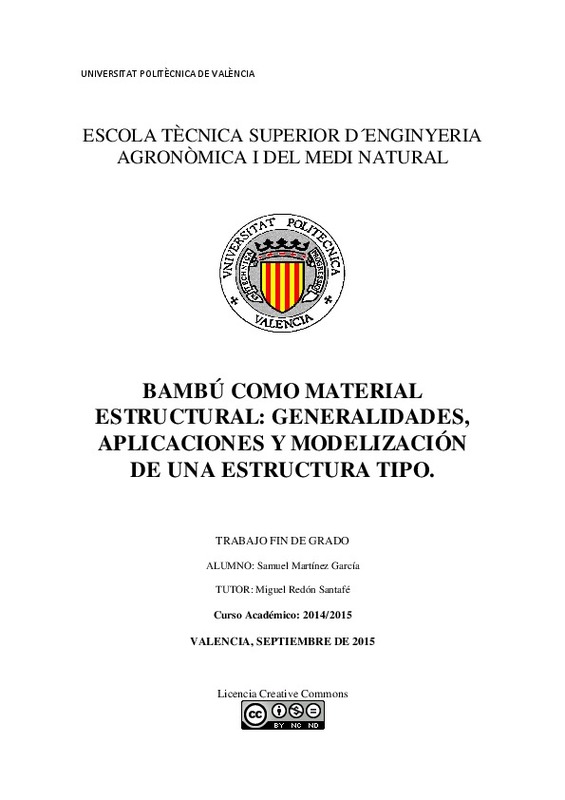JavaScript is disabled for your browser. Some features of this site may not work without it.
Buscar en RiuNet
Listar
Mi cuenta
Estadísticas
Ayuda RiuNet
Admin. UPV
Bambú como material estructural:Generalidades, aplicaciones y modelización de una estructura tipo
Mostrar el registro sencillo del ítem
Ficheros en el ítem
| dc.contributor.advisor | Redón Santafé, Miguel
|
es_ES |
| dc.contributor.author | Martínez García, Samuel
|
es_ES |
| dc.date.accessioned | 2015-10-14T16:09:04Z | |
| dc.date.available | 2015-10-14T16:09:04Z | |
| dc.date.created | 2015-09-09 | |
| dc.date.issued | 2015-10-14 | es_ES |
| dc.identifier.uri | http://hdl.handle.net/10251/55983 | |
| dc.description.abstract | [ES] Este trabajo trata de exponer y dar a conocer las posibilidades del bambú como material de construcción. El bambú es una planta de distribuida a lo largo y ancho del planeta, a excepción de Europa y la Antártida. Es un vegetal de crecimiento rápido, por lo que su aprovechamiento se ve favorecido al poder tener turnos de corta muy reducidos. Su uso como material de construcción es una ventaja medioambiental ya que estamos sustituyendo acero y hormigón (materiales con un elevado coste energético) por un material renovable y sostenible que es un excelente fijador de carbono atmosférico, ayudando así a mitigar el cambio climático. En cuanto a las características mecánicas, gracias a ensayos y estudios se ha verificado que es un perfecto competidor de la madera, siendo superior en algunas de sus cualidades. Sin embargo, como desventajas cabe mencionar el tema de las uniones que tienden a agrietar y fisurar el material. El presente trabajo final de grado tiene como objetivo principal establecer la aptitud estructural del material bambú dentro de tipologías constructivas que actualmente se desarrollan en madera estructural. El contenido que se presenta se organiza a partir del estudio de las aptitudes mecánicas del bambú. Se describen los aspectos generales de la construcción en bambú así como implicaciones medioambientales. Se exponen las tipologías estructurales principales a nivel mundial y asimismo, se analizan las intervenciones realizadas a nivel nacional evaluando con especial atención su creciente interés y potencial futuro de utilización. La revisión crítica del estado del conocimiento permite establecer las bases conceptuales y de diseño para seleccionar una estructura tipo en bambú con la que realizar una modelización de cálculo estructural verificando sus condiciones de estabilidad y seguridad. A su vez, los resultados obtenidos se comparan, para la misma estructura, con los obtenidos con el material madera. Finalmente, el estudio comparativo permite obtener una serie de conclusiones y recomendaciones relativas al potencial de utilización del bambú como material estructural en ámbitos geográficos fuera de sus zonas de producción. | es_ES |
| dc.description.abstract | [EN] This document attempts to explain the possibilities of bamboo as a building material. Bamboo is a plant distributed throughout the world, except Europe and Antarctica. It is a plant of rapid growth, so its use is favoured to be able to have very low short shifts. Its use as a building material is an environmental advantage because we are replacing steel and concrete (materials with high energy costs) for a renewable and sustainable material. Bamboo is an excellent fixative atmospheric carbon, thereby helping to mitigate climate change. As for the mechanical properties, tests and studies have verified that it is an ideal competitor of wood, being higher in some of his qualities. However, the main disadvantage is related with the design of unions between elements, joints tend to crack. The key objective of the present final degree is setting the structural ability of bamboo within the constructive typologies that nowadays are used in structural wood. The contents of the work are organized, firstly, from the study of the mechanical skills of bamboo. Secondly, general aspects of bamboo construction together with environmental implications are described. The outstanding structural design performed with bamboo worldwide are analysed. Also, bamboo works at national scale are evaluated drawing the attention into its growing interest and future use. From the analysis of the previous state of the art, a particular bamboo structure is designed performing its structural verification in terms of stability and safety. The same basic structure is performed with solid wood with the aim of comparing the results between both materials. Finally, the comparative study provides setting some conclusions and recommendations regarding the potential use of bamboo as a structural material in geographical areas away from the production areas. | es_ES |
| dc.language | Español | es_ES |
| dc.publisher | Universitat Politècnica de València | es_ES |
| dc.rights | Reconocimiento - No comercial - Sin obra derivada (by-nc-nd) | es_ES |
| dc.subject | Bamboo constructions | es_ES |
| dc.subject | Structural analysis | es_ES |
| dc.subject | Wood structures | es_ES |
| dc.subject | Construcción en bambú | es_ES |
| dc.subject | Calculo estructural | es_ES |
| dc.subject | Estructuras de madera | es_ES |
| dc.subject.classification | INGENIERIA AGROFORESTAL | es_ES |
| dc.subject.other | Grado en Ingeniería Forestal y del Medio Natural-Grau en Enginyeria Forestal i del Medi Natural | es_ES |
| dc.title | Bambú como material estructural:Generalidades, aplicaciones y modelización de una estructura tipo | es_ES |
| dc.type | Proyecto/Trabajo fin de carrera/grado | es_ES |
| dc.rights.accessRights | Abierto | es_ES |
| dc.contributor.affiliation | Universitat Politècnica de València. Departamento de Ingeniería Rural y Agroalimentaria - Departament d'Enginyeria Rural i Agroalimentària | es_ES |
| dc.contributor.affiliation | Universitat Politècnica de València. Escuela Técnica Superior de Ingeniería Agronómica y del Medio Natural - Escola Tècnica Superior d'Enginyeria Agronòmica i del Medi Natural | es_ES |
| dc.description.bibliographicCitation | Martinez Garcia, S. (2015). Bambú como material estructural:Generalidades, aplicaciones y modelización de una estructura tipo. http://hdl.handle.net/10251/55983. | es_ES |
| dc.description.accrualMethod | TFGM | es_ES |
| dc.relation.pasarela | TFGM\31260 | es_ES |
Este ítem aparece en la(s) siguiente(s) colección(ones)
-
ETSIAMN - Trabajos académicos [3541]
Escuela Técnica Superior de Ingeniería Agronómica y del Medio Natural





![PDF file [Pdf]](/themes/UPV/images/pdf.png)

